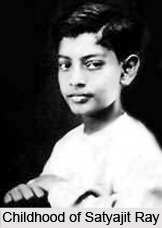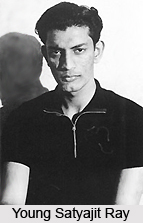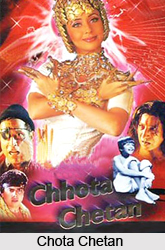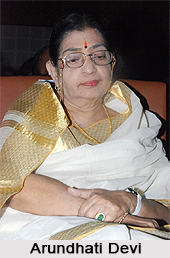 Satyajit Ray was born on 2nd May 1921, the year his father Sukumar Ray fell seriously ill. He belongs to an affluent family in Kolkata and is the grandson of Upendrakishore Ray Chaudhuri, was a distinguished writer, painter, a violin player and a composer. Upendrakishore, pioneer in half-tone block making and founded one of the finest presses in the country - U. Ray & Sons, died six years prior to the birth of Satyajit Ray.
Satyajit Ray was born on 2nd May 1921, the year his father Sukumar Ray fell seriously ill. He belongs to an affluent family in Kolkata and is the grandson of Upendrakishore Ray Chaudhuri, was a distinguished writer, painter, a violin player and a composer. Upendrakishore, pioneer in half-tone block making and founded one of the finest presses in the country - U. Ray & Sons, died six years prior to the birth of Satyajit Ray.
In the 1880`s `Brahmo Samaj` was embraced by the family of Satyajit Ray. As a reaction to Christianity, `Brahmo Samaj was set up, to take care of the western literature and abolish traditional Hindu practices like `Sati`. With a logical and progressive outlook of Brahmo Samaj, Satyajit Ray`s work was greatly influenced by the same. Later on the movement of Brahmo Samaj was led by Devendranath Tagore. Many of Satyajit Ray`s films like; Devi, Charulata, Teen Kanya, Sadgati, Ghare Baire and Ganashatru have been influenced by the philosophy of Brahmo Samaj.
Early Childhood of Satyajit Ray, 1926
After Sukumar Ray`s death the printing house shifted hands, as a result Satyajit along with his mother had to leave their spacious house, and move to maternal uncle`s house. Those were tough days and his mother taught needlework to supplement the household income. It was here that he met cousin Bijoya, his future wife, for the first time. From a very young age he had been taught by his mother, but when he was eight years old, Satyajit joined Ballygunj Government School.
The love for films developed while he was at school, where he regularly read Hollywood trivia in magazines like Photoplay and Picturegoer. He also had keen interest in western classical music too. He would often pick-up gramophone records at flea markets.
College Life of Satyajit Ray, 1936
Satyajit Ray was not very keen on studies and on his mother`s insistence he enrolled at Presidency College, where, for the first two years he read science, and for the third year, he took economics. (An uncle had assured him a job if he graduated in economics). Satyajit started to spend more and more time watching films and listening to western classical music on his gramophone, all these at the expense of academics.
Once he started watching various types of films his interest had shifted from stars to the filmmaker, highly appreciating the works of John Ford, Frank Capra, Ernst Lubitsch and William Wyler. He became a regular member of Sight & Sound.
In the year 1939, he graduated from Presidency College, and decided to discontinue with studies. In spite of having no formal training he decided to pursue his career as a professional artist. But his mother was against him taking up a job at such a young age and she felt he should join as a student of painting at Shantiniketan.
Discovery of Oriental Art by Satyajit Ray, 1940-41
 After initial reluctance Satyajit Ray decided to enrol as a student of art at Vishva-Bharati University in Shantiniketan. The desire to be successful in the field of painting and lure of Rabindranath Tagore were too strong to let go. During his stint as a student of art he realized certain concepts for the first time. It was here that he encountered Indian villages for the first time. He also discovered the essence of oriental art- Indian sculpture and miniature painting, Japanese woodcuts and Chinese landscapes. Till then, his knowledge was limited to only westernized art forms. His love and affection for Indian grew during this time and also realized the use of minute details in Indian art to imply a bigger meaning. This is an idea which has been used by him many times in his films. His art teacher at Shantiniketan was Binode Behari Mukherjee, who had a profound mark of him. Satyajit made a documentary on Binode Behari Mukherjee - The Inner Eye, 1972, as a tribute to his mentor.
After initial reluctance Satyajit Ray decided to enrol as a student of art at Vishva-Bharati University in Shantiniketan. The desire to be successful in the field of painting and lure of Rabindranath Tagore were too strong to let go. During his stint as a student of art he realized certain concepts for the first time. It was here that he encountered Indian villages for the first time. He also discovered the essence of oriental art- Indian sculpture and miniature painting, Japanese woodcuts and Chinese landscapes. Till then, his knowledge was limited to only westernized art forms. His love and affection for Indian grew during this time and also realized the use of minute details in Indian art to imply a bigger meaning. This is an idea which has been used by him many times in his films. His art teacher at Shantiniketan was Binode Behari Mukherjee, who had a profound mark of him. Satyajit made a documentary on Binode Behari Mukherjee - The Inner Eye, 1972, as a tribute to his mentor.
Even when he was at Shantiniketan he listened to variety of western music and watched world cinema. He would borrow books from university library and read books on cinema like Paul Rotha`s `Film Till Now` and Raymond Spotiswoode`s `Grammar of the Film. Though his love for films was very much there, but that he would become professional filmmakers had not crossed his mind till then.
Ray Returns to Kolkata after Tagore`s Death, 1942
Tagore died in the year 1941 and it was a personal loss for Ray. In the later half of 1942, Satyajit started to miss the city life of Kolkata as a result made frequent trips to the city during weekends, visiting his mother and cousin Bijoya.
While at Shantiniketan he missed the entire happenings of the country and in December 1942, Satyajit left Shantiniketan for his home in Kolkata.






